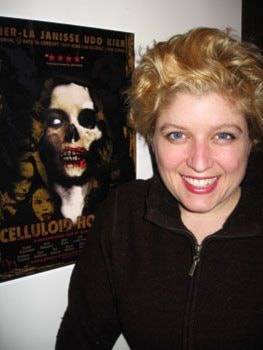In tarot lore the fool is a man who doesn’t look before he leaps.
He is exuberant and unknowing, and he has a tragic flaw. In fact, the character is often shown stepping off the edge of a cliff with a silly smile on his face.
But this is not your traditional tarot deck.
Local painter Neil Graham took a different approach to portraying the archetype — he depicted the fool as an artist.
In Graham’s painting the character is wearing a striped shirt and blue jeans. He clutches a palette in one hand and a paintbrush in the other ready to attack a canvas.
“I couldn’t help making the artist the fool,” said Graham with a laugh, and listed a litany of reasons for his choice.
“It’s a hard way to make a living,” he said. “We don’t make very much money, and most of our time is spent banging our heads against a wall.”
The Fool is just one of 22 unconventional Yukon-themed cards that Graham painted for the latest exhibition at the Yukon Arts Centre, The Tarot Show.
The order of the cards, which begins with The Fool and ends with The World, is symbolic of a life path.
In between the two ends sit other formidable characters such as Death, The Emperor, The Sun, The Hermit and The Devil.
“This devil was easy for me to do,” said Graham as he ran a finger over his painting of the beast’s sharp horns. “I often get visited by these demonic creatures in my sleep.”
The Tarot Show is a new creation from the Studio Gallery Association, an eight-artist group made up of sculptors and painters from Atlin, BC, and Whitehorse (and former Yukon-based artist Janet Moore).
The 10-year-old association chose to tackle the tarot, building on the success of its 2003 Chess Show, which worked on a similar idea but drew upon the game’s kings, rooks and knights for source material.
For the past two years, the group has focused its attention on the mystical tarot, a topic chosen for its universality and potential for creativity.
“It’s a font of symbolism,” said Graham. “It’s something that can be interpreted by everyone in a different manner – it’s fascinating.”
With a cursory glance around the room, it’s easy to see that each of the eight artists took a very different approach to the subject.
And each of their pieces is bursting with symbolism.
In Heather Hyatt’s superb paintings Death symbolizes rebirth; in Janet Moore’s work a bowl stands in for the body and in Rob Ingram’s distinctive watercolour paintings a beach umbrella represents hope.
Opposite Graham’s paintings hang two large cards created by fabric artist Meshell Melvin.
In one, a naked Adam and Eve stand before the Atlin mountains (Atlin is Melvin’s “little piece of Eden”).
Above the pair sits an angel, a higher power, gazing down toward Earth.
Melvin can spend 20 minutes explaining the meaning behind the images and their compositions and still have a lot more to tell.
For her, thinking about the tarot brings to mind a snippet of a Stuart McLean story.
In it a young boy, Sam, goes to see a ‘psycho’ to have his cards reads. The psycho asks him if he knows anything about the tarot and Sam answers, ‘No.’
She replies, ‘That’s good — nobody does,’ said Melvin with a laugh.
The tarot dates back to 1200.
The lofty subject matter it deals with is portrayed in pictures so those ideas had a way to be discussed, she explained.
“It transcends language.”
Like Graham, it’s not essential to her that the viewer understand every symbol to enjoy the painting (although there are interpretive books strewn around the gallery for the ambitious viewer).
Filling an image with symbols and metaphors is natural for an artist, said Graham, whether they realize it or not.
“And it can be enjoyed on the surface as a nice painting, or it can be explored through a deeper interpretation.”
Sometimes, it’s OK to leave the viewer wondering, added Melvin.
“That’s part of the practice of art — asking questions. If we look at a piece of art and we have a lot of questions that means there is something going on there.”
Beside Melvin’s fabric art, in a walled-off corner of the gallery Sheila Alexandrovich’s sculptural installation took a very different approach to presenting the cards.
Using bone, fur, wood and beads, Alexandrovich created a series of wands; each one corresponds to a character in the deck.
She did little research before crafting the pieces, and tossed aside the interpretation books in favour of developing her own response and cadre of images.
“I figured the tarot is not about to tell me something that I don’t already know,” she said. “It’s all there — we just don’t pay attention.”
So Alexandrovich went back to her roots, literally, and used her experience communing with nature to guide her artwork.
“For me the tarot just symbolizes another way of looking at the world,” she said.
The Tarot Show will hang at the arts centre until December 23.
